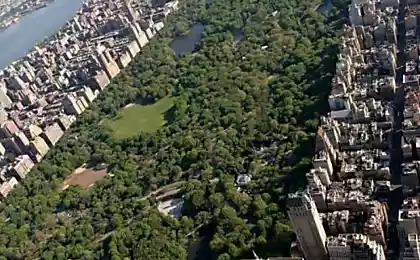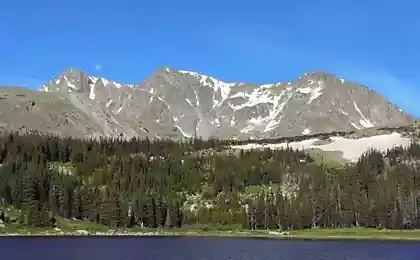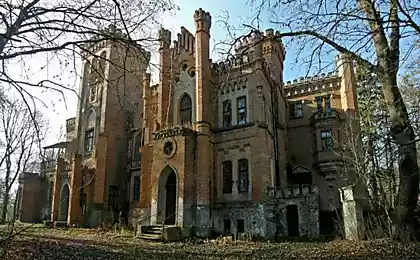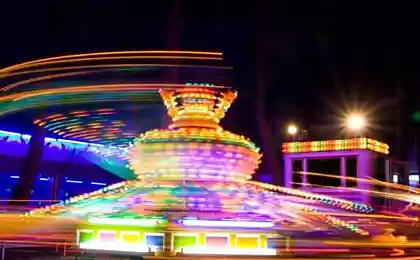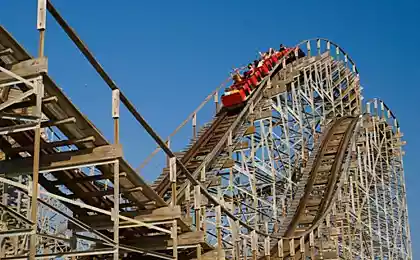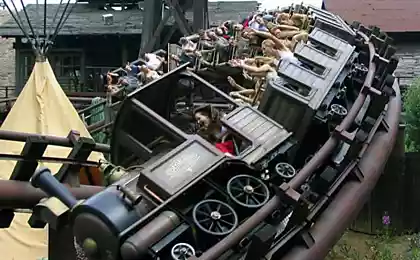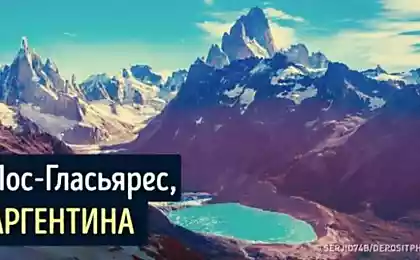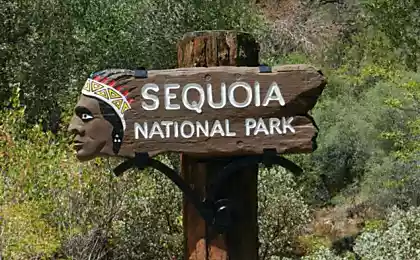939
Park "Sofiyivka" Uman (60 photos)
Park "Sofiyivka" Uman is considered one of the best landscape parks in Europe. On an area of about 170 hectares, you can see the amazing landscapes, exotic plants, antique sculptures, ponds, waterfalls, fountains and stone grottoes.
As planned by the creators of the park - "Sofiyivka" is a graphic illustration of the poems of Homer's "Iliad" and "Odyssey", each composition or architectural form contains certain ideas, it expresses the idea of myth and what that event. Here you can see the river Styx, Tarpeian Rock, numerous sculptures of ancient Greek heroes, writers, philosophers.
The main composition of the park runs along the bed of the Kamenka, which was built a number of separate pools and ponds: Upper - more than 8 hectares, Lower - about 1, 5 ha and other waterfalls (one of them 14 meters high), gateways, waterfalls, underground river Acheron.
The history of the park "Sofiyivka»
Sofievka was built the owner of the city of Uman Polish magnate Stanislav Potocki for his beloved wife, the beautiful Greek woman - Sofia.
The author of the topographical and architectural design, construction manager of the park was appointed a Polish military engineer Ludwig Metzel. Built his castle Potocki, but not for free - farmers were paid, it was dictated by the general chinshem, which was wound up Potocki.
Location for the park was very well chosen - a small river, oaks, ravines and piles of granite boulders, natural springs with crystal clear water ... From 1796 to 1802 digging ponds and trenches for underground rivers, constructed waterfalls, grottos were cut down, laid the alley. They were planted plants of both local and imported breeds from around the world. Garden decorated brought from Italy, marble statues of Greek gods and goddesses, philosophers and poets. Just a few years Uman builders and gardeners have created a miracle. The park was opened in May 1802, although the work had not yet been fully completed. Potocki presented the park on the day of Patron Saint Sophia and named in honor of her "Sofievka».
End Park on the original plan failed - Potocki died suddenly in 1805. After the death of Sophia Park was inherited by her son Alexander, however, for taking part in the Polish uprising of all the estates of Potocki, including Park were confiscated.
In the mid-19th century, the park was carried out restoration work, the construction of new facilities - such as the Rose Pavilion on the island of Anti-Circe, the pavilion of Flora Fountain and Snake.
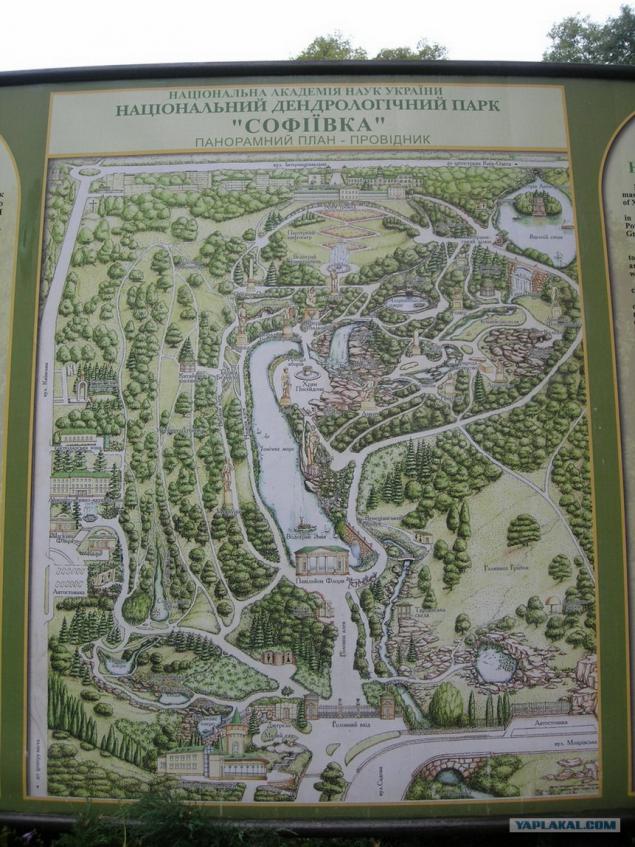
The southern part of
1.home creative scientists of the National Academy of Sciences of Ukraine. This house has the original architecture, and on top of the building - an observation platform.

2. Park begins with the main entrance on the street Sadovaya. Behind him there is a central avenue. The main entrance of the Tower, erected in 1850-1852, respectively, survived to our time, along with an entrance gate. Fence from towers over one and a half centuries, has changed many times - from wood to clay-poster, a metal on granite columns.
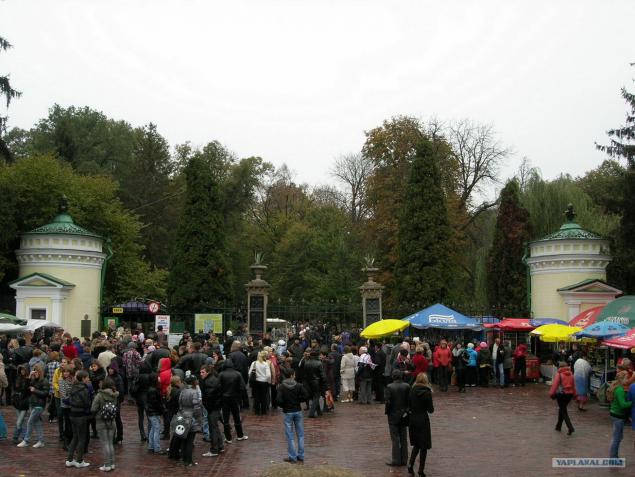
3.Tsentralnaya alley.
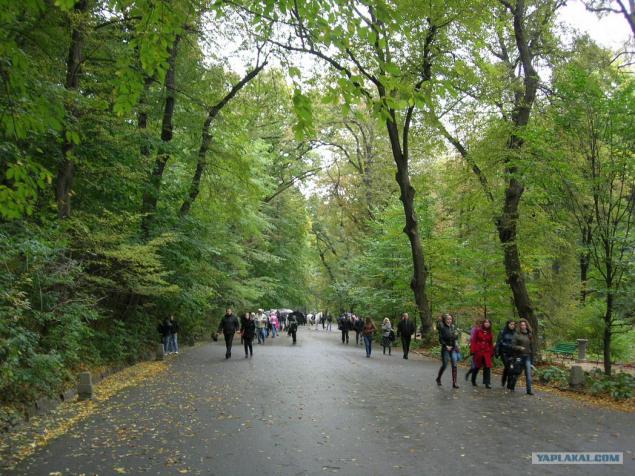
4.Rechka Kamenka. It passes through the entire territory of the park.
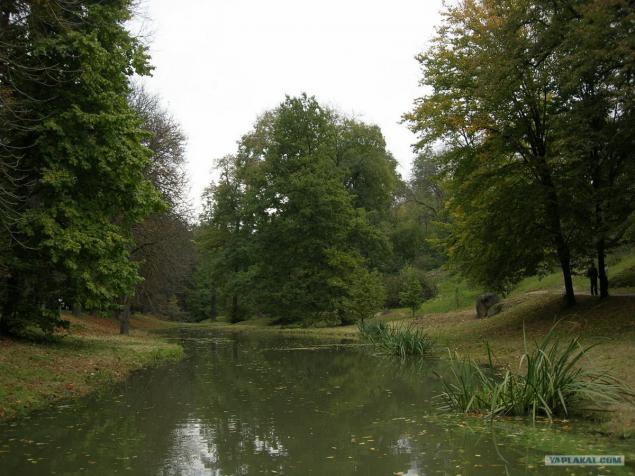
5.Zhenevskoe lake.
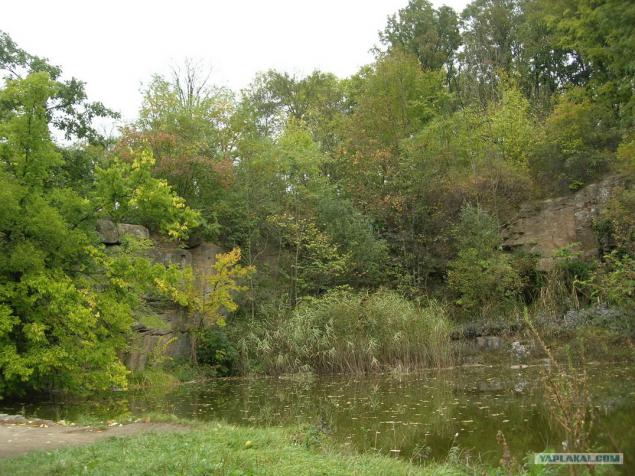
6.Malaya Switzerland. Swamp cypress (planted in 1891).
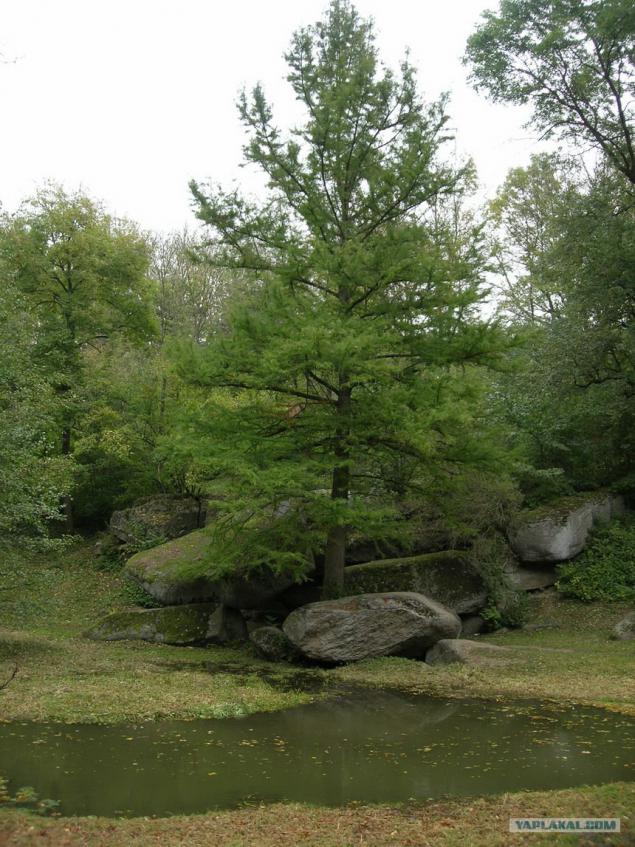
7. Tayperskaya rock located to the right along the main avenue. It is a wooden gazebo light construction, which continues to rock. For the first time it established in 1839, and later, when the dilapidated - was removed, and only in 1950 was rebuilt again. The Rock is named the same as the western wall of the Capitoline fortress of Ancient Rome, which has been preserved to our time.
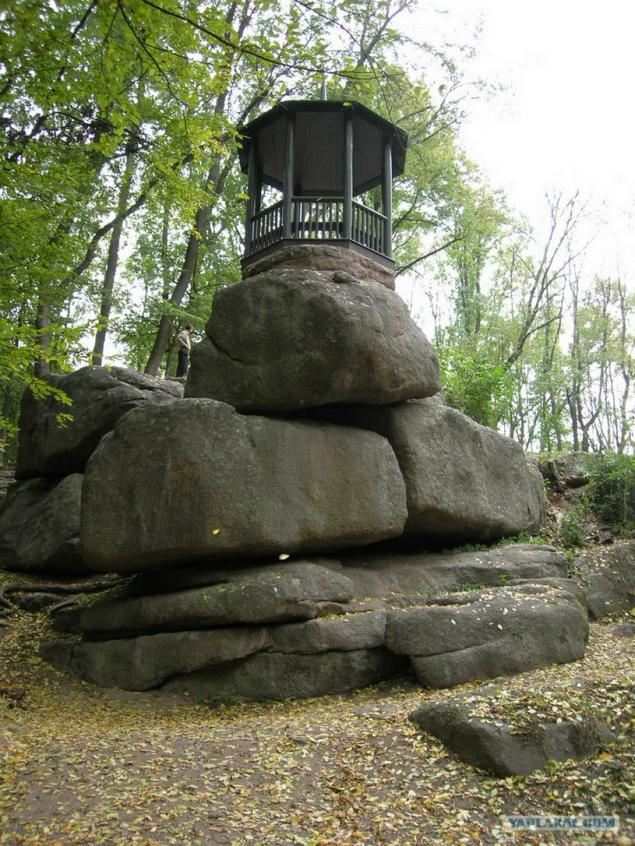
8. Near the Pavilion de Flore looks exquisite, thanks to its precise architectural forms, a tall column in the Doric style, bas-relief on the frieze, which depicts the leaves and bunches of grapes. Ornament executed in 1852 by academician of architecture drawings AI Shtakenshnejdera.
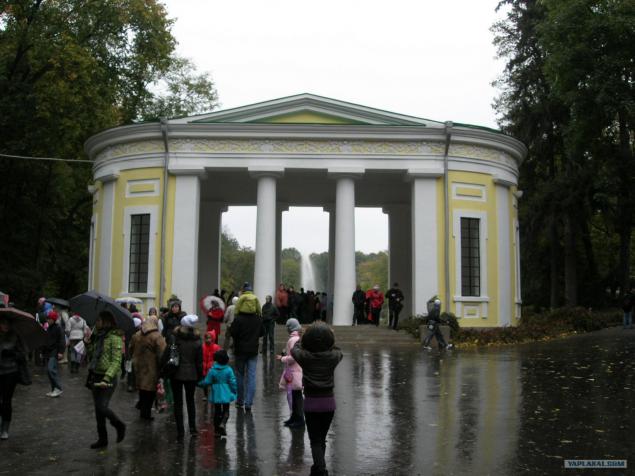
The central part of
9. In the framework of the composite decision of the central part of the park put scenes from the mythology of ancient Greece and Rome, and some places resemble the home of the Greek gods, heroes, writers and philosophers.
To the right of the pavilion of Flora is filled wedge of granite stone arch set the so-called Venetian bridge. The bridge is decorated with granite pylons, between which hang heavy forged chain. Slightly below the wooden bridge is the gateway to the passage of water into the channel of the river Kamenka.
In the middle of the Ionian Sea from the wide-open mouth of a snake writhing on the stone hits the water column - Fountain of Serpent.

10. Fountain Snake.
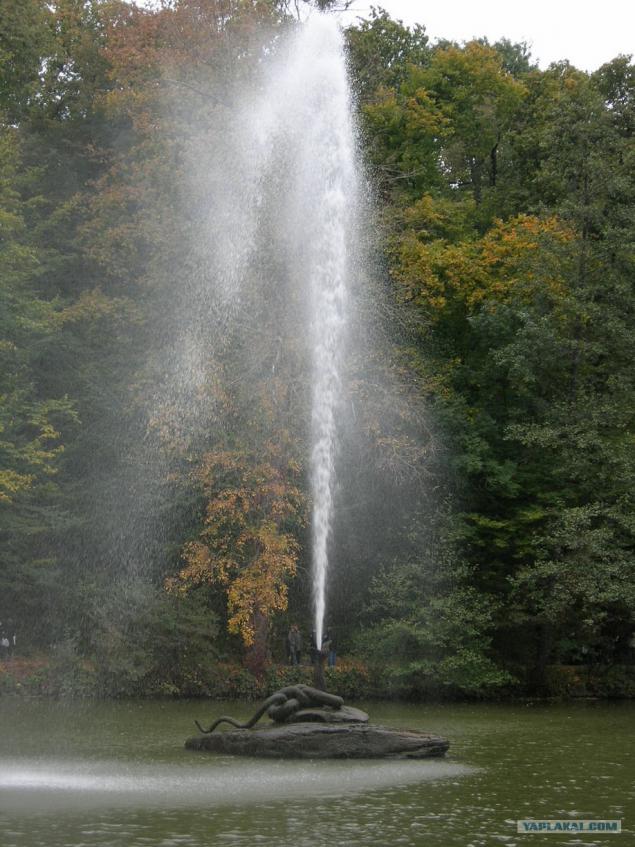
11.Ionicheskoe sea.
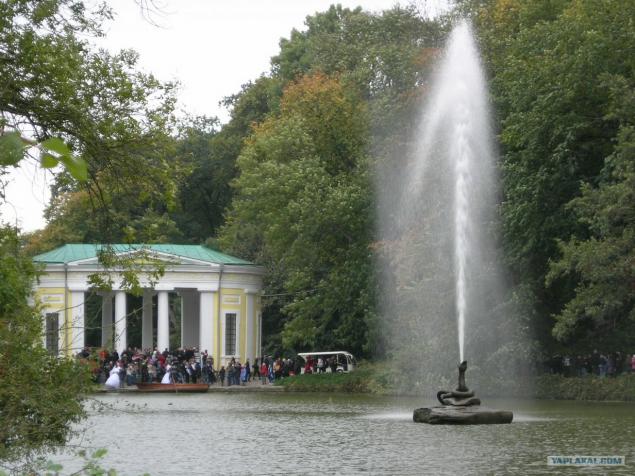
12.Venetsiansky bridge.
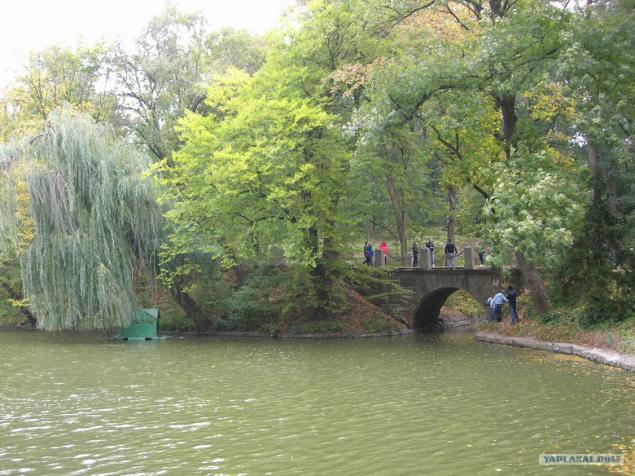
13.Granitnye Venetian bridge pylons.
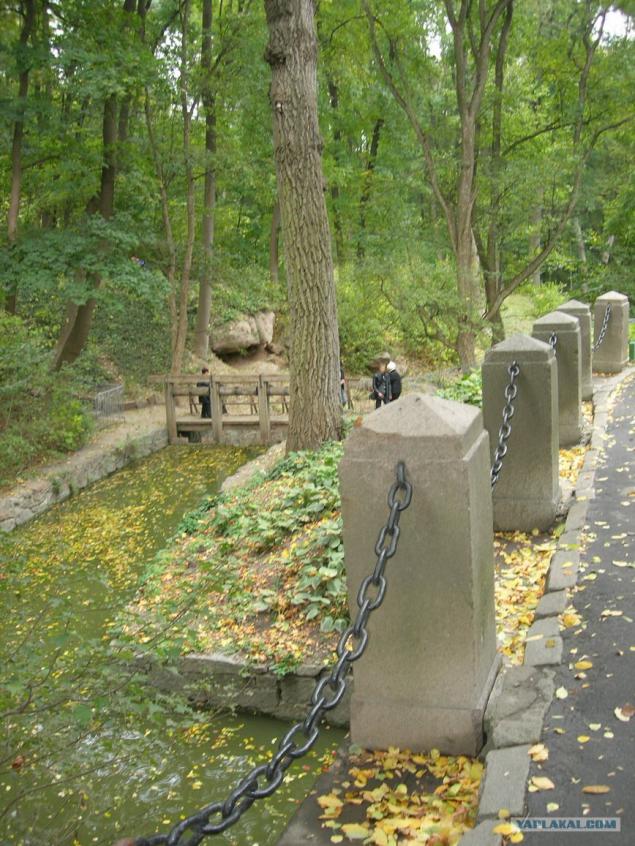
14.Derevyanny gateway.

15. In the area on the top avenue - there is a statue of Hermes (the Romans - Mercury). This statue is located in the park since 1800, has repeatedly restored.
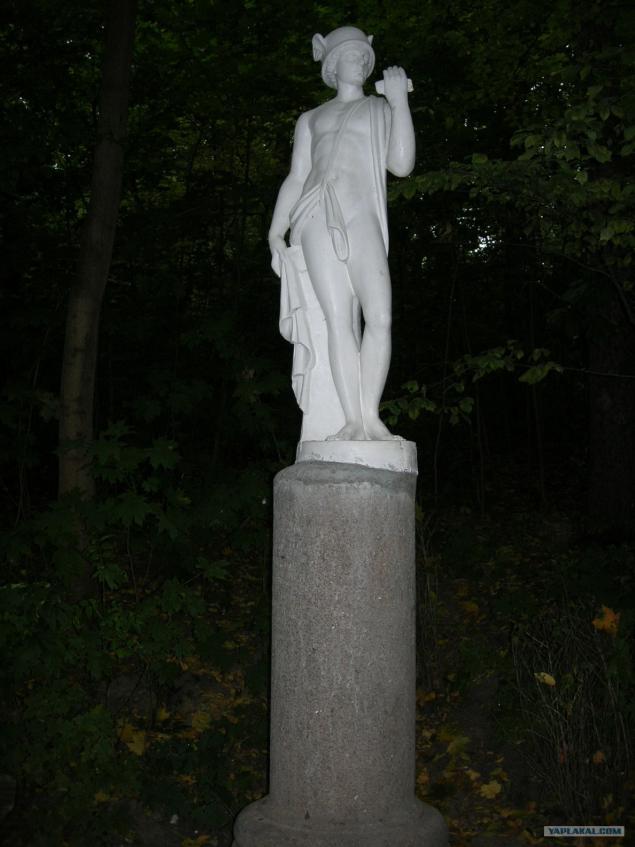
16.Verhnyaya alley.
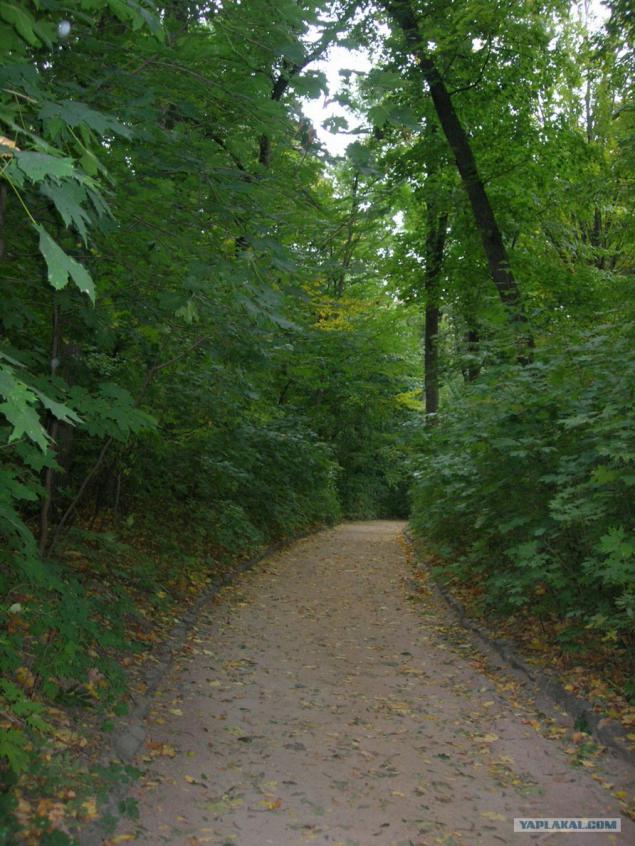
17. At the end of the Lower alley located on a high granite pedestal, a two-meter statue of the ancient Greek poet playwright Euripides. It depicts a full-length with a scroll in his right hand and a bundle of manuscripts about the legs. Euripides is the only sculpture in the park, which is not rearranged to another place since its establishment in 1800. In 1996, all the original marble sculpture was moved to the museum, and in their place installed copies of plaster and Plexiglas.
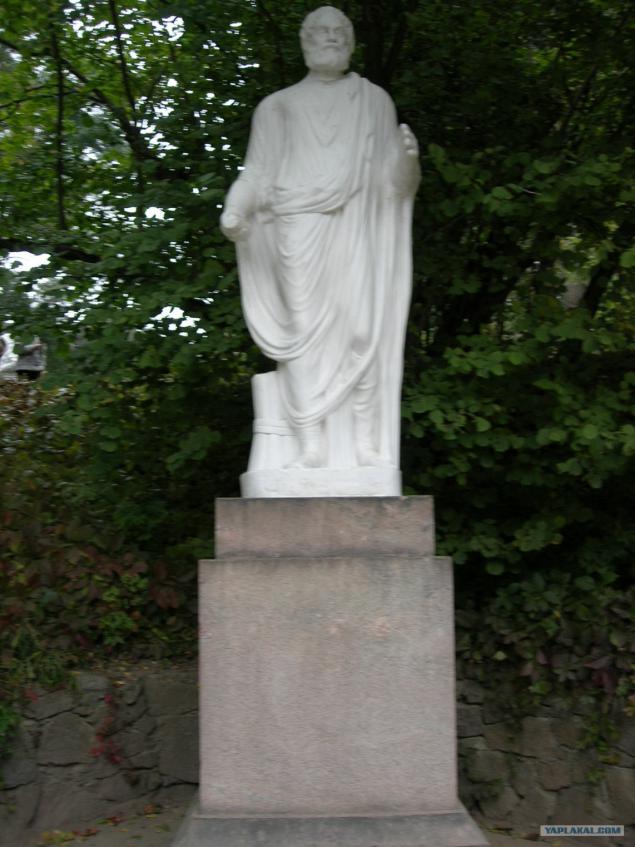
18.Terrasa muses and Apollo grotto by the Assembly Square.
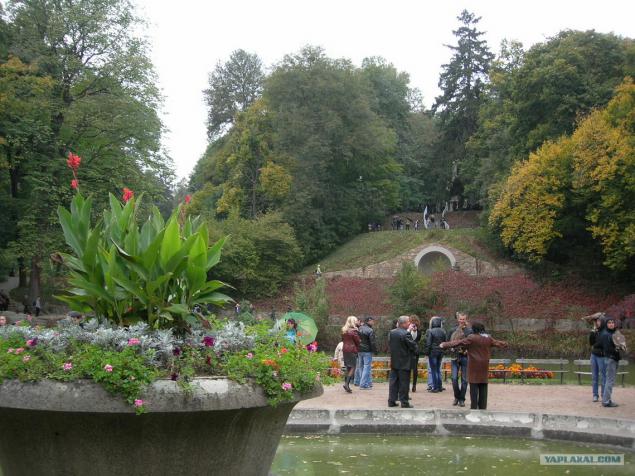
19.Apollon Belvedere.
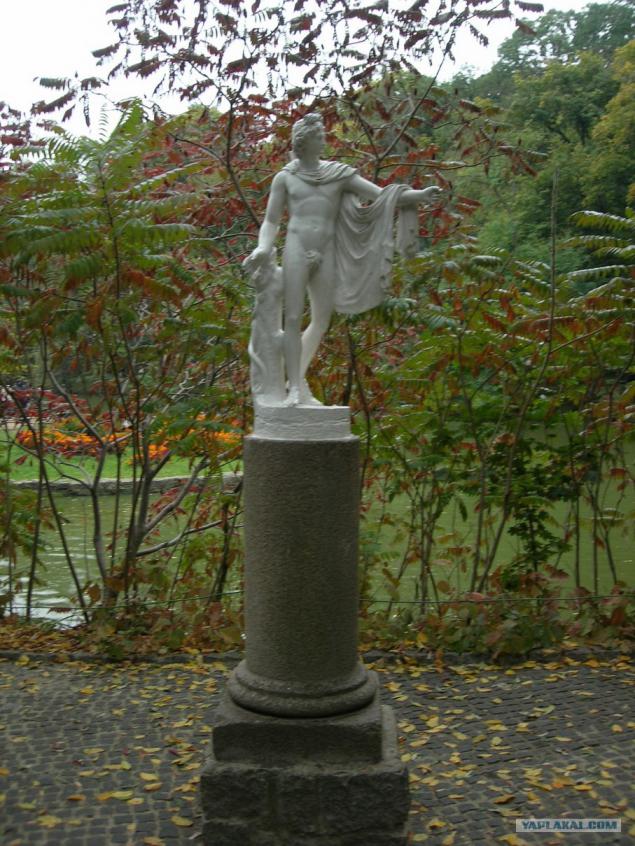
20. On a square near the source of the podium in 1851 installed a statue of Venus bathing, which had previously stood in the grotto of Apollo. Now at this point is a copy in plexiglass, made in 1952. Below the statue from granite pedestal running spring water, which at any time of the year has the same temperature. Water fills the bronze half-shells, decorative depicting snakes, and poured it over the edge, flows down the granite underground channels in the Ionian Sea.
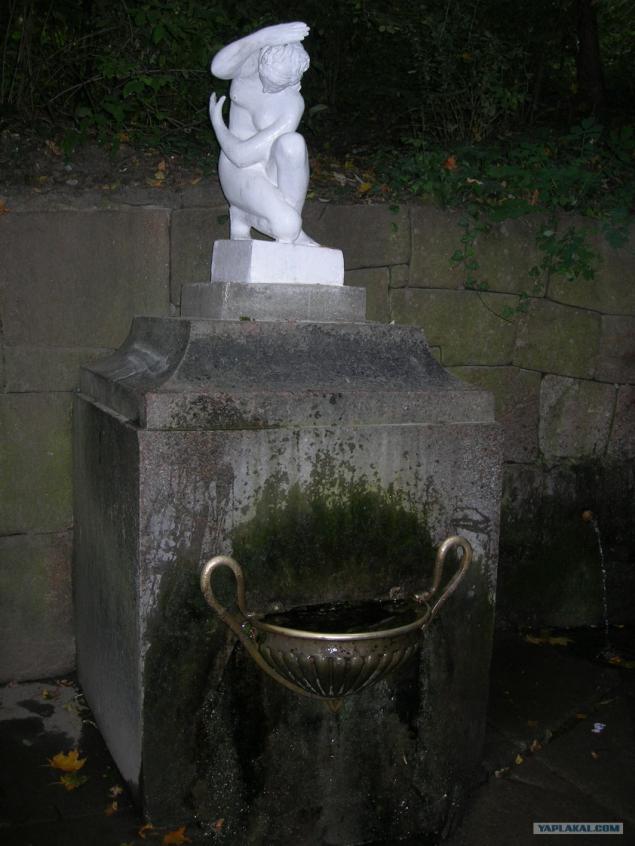
21. Through the Ionian Sea to the collecting area leads metal bridge with views of the Great Falls. Water comes here through the underground river Acheron from the Upper Pond. Built waterfall in the first period of the park.
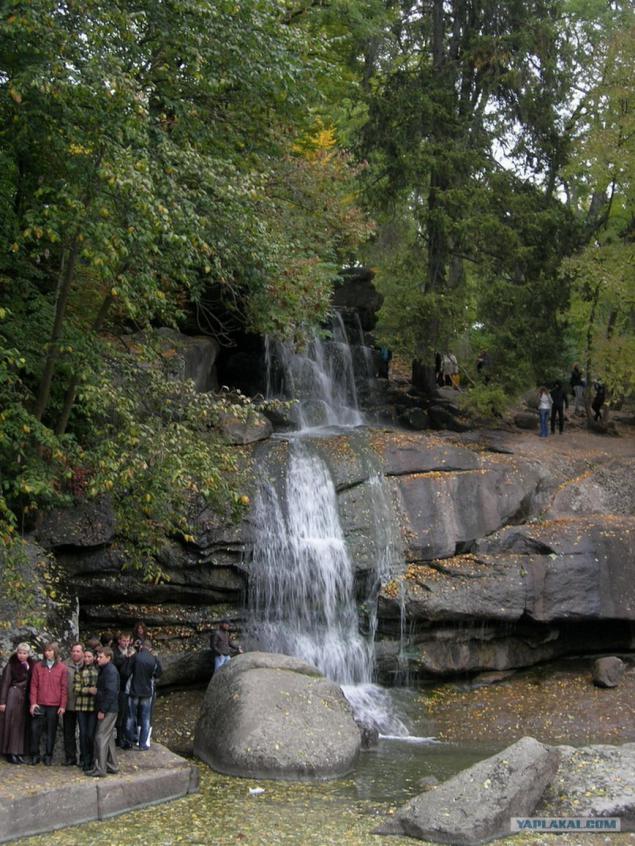
22.Prohod a large waterfall.

23. The area is framed by wooden benches fees. It is situated on a peninsula oval. In the center is a swimming pool in the middle of which is placed a large granite vase. The pool swim ornamental fish. The water in the pool passes through the underground cast iron pipe from the Upper Pond and is kept at the same level, because the water level is displayed in the Ionian Sea through the padded underground granite canal. In summer, the vase is decorated with bright colors. Around the pool is a statue of Paris.

24. Statue of Paris.
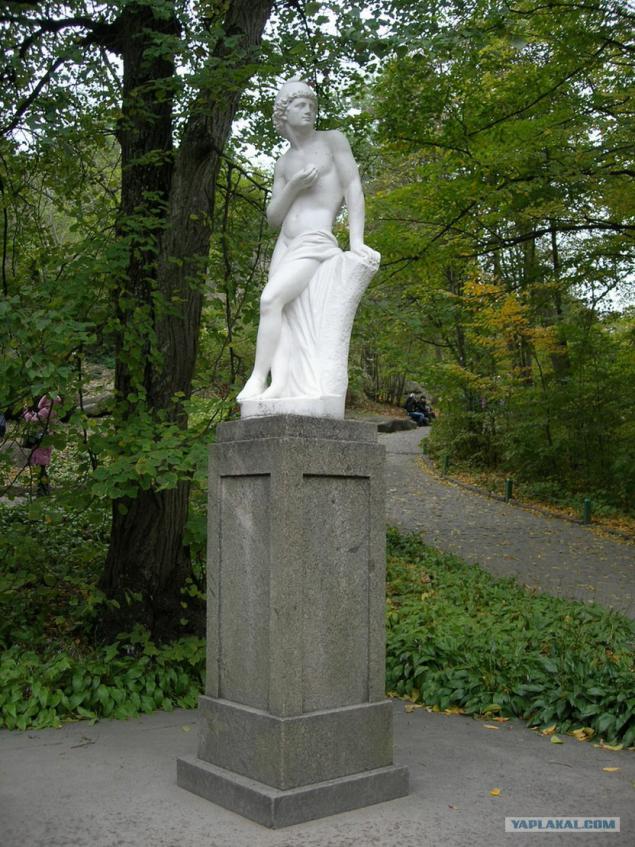
25. The Valley of the Giants. To the left of the square is the grotto. A large granite boulder weighing more than 300 tons, hung without the support and rests only on three points. The reliability of this building checked by nature. In 1838, 1976, 1986, when there was a significant force Uman earthquake grotto remained intact. Grotto Grotto is called fear and doubt (early name - Grotto of Tantalus).

26. Above the grotto of Fear and doubt about Big Falls is a small pedestal. Once there was a statue of Cupid, made of white marble. From the original preserved only the wings of Cupid. In 1996, the photographs, she cast Kiev sculptor Ivan D. Didur from organic materials and is installed in its place. The statue depicts a boy who had scattered all his arrows, Teteven, which connects the ends of the bow, broken. In the background, Grand Falls.
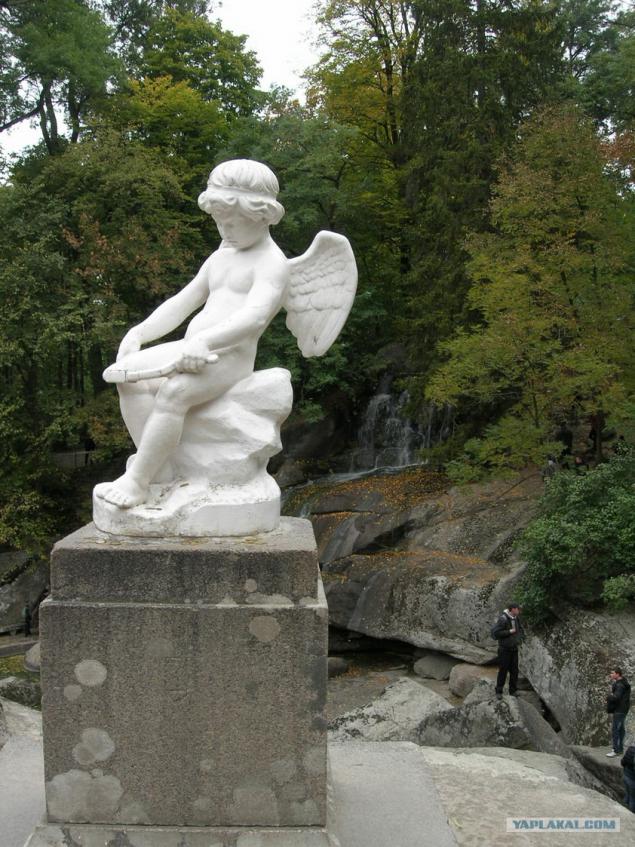
27. Above Areas fees go up granite steps along the large granite boulders. To the left is West grotto (the grotto of Scylla). The grotto is made of pink granite, there are granite benches and a table.
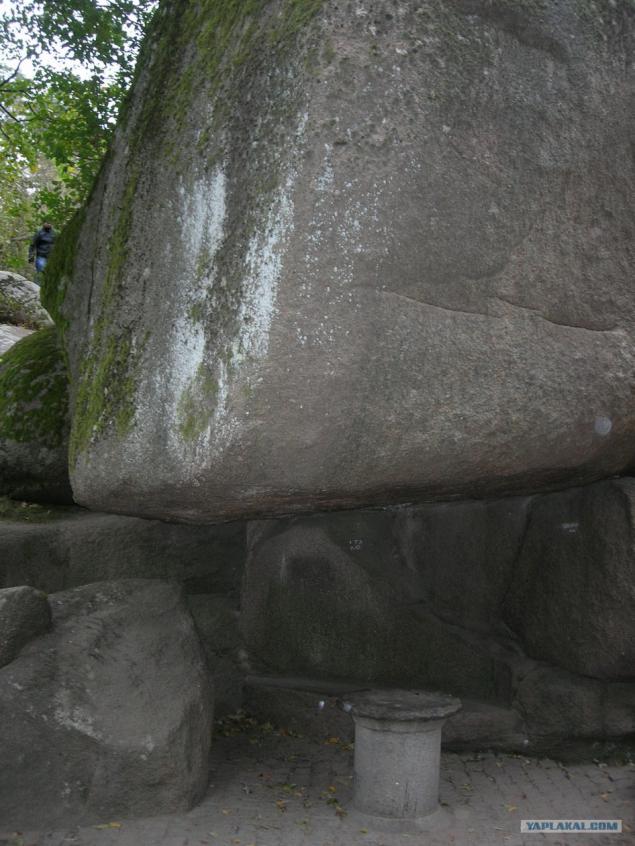
28.Kamni symbolize the island of Ithaca.

29.On the same.

The eastern part of
30. Figure east of the statue is a bridge across the Amur River Kamenka track that leads to the Vale of Tempe. At this point, Ludwig Metzel tried to create a prototype of Greek Vale of Tempe. It grew 9 birches that allegorically displayed the nine sons Potocki. Two of them (Kostantin and Nicholas) had died at an early age, as Potocki's daughter Helena. As the memory of their early death in the valley of a granite obelisk, which is called "truncated column" (Column of Sorrow).
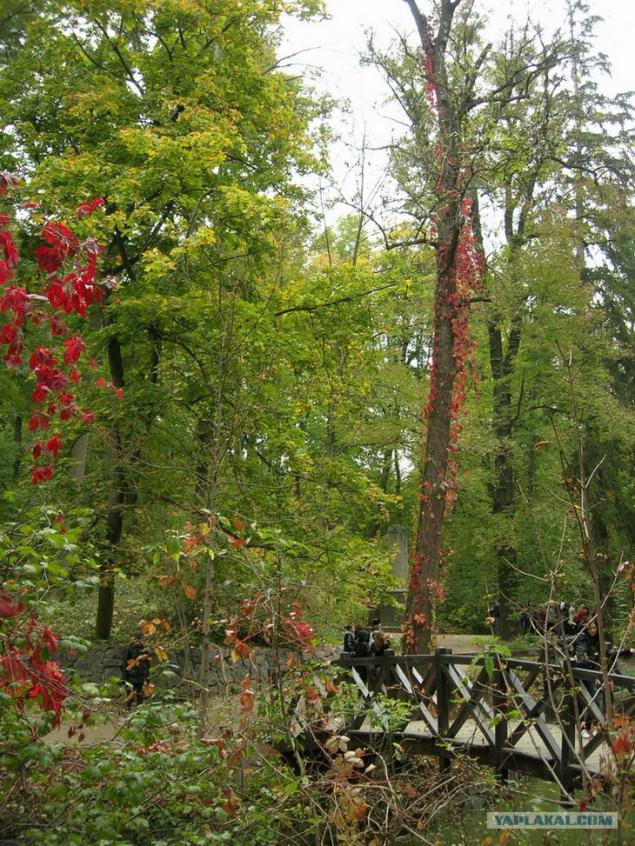
31. Near the creek flowing river Kamenka, divided into three separate small waterfall. They are called "Three Tears" and express their sorrow allegorical mother of three dead children.
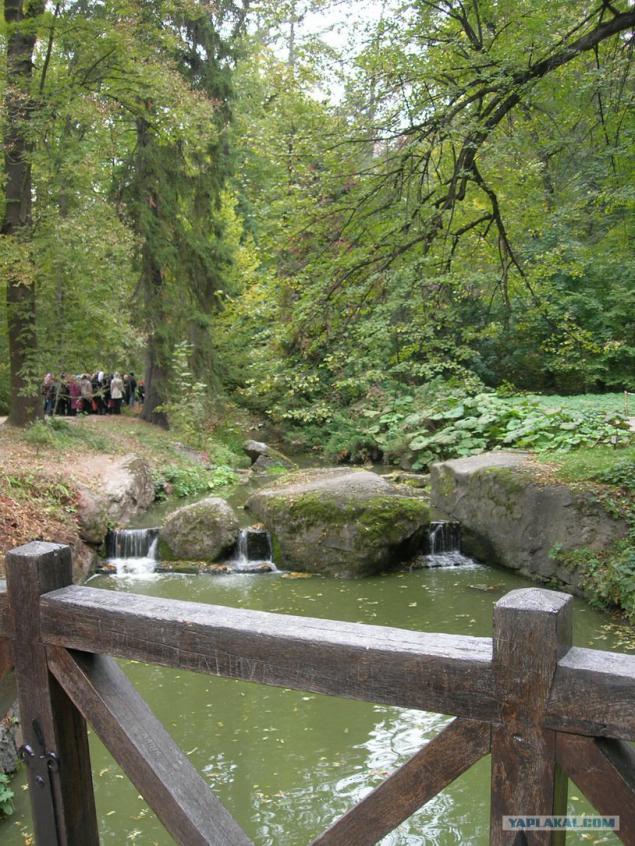
32.Kolonna Sorrows.
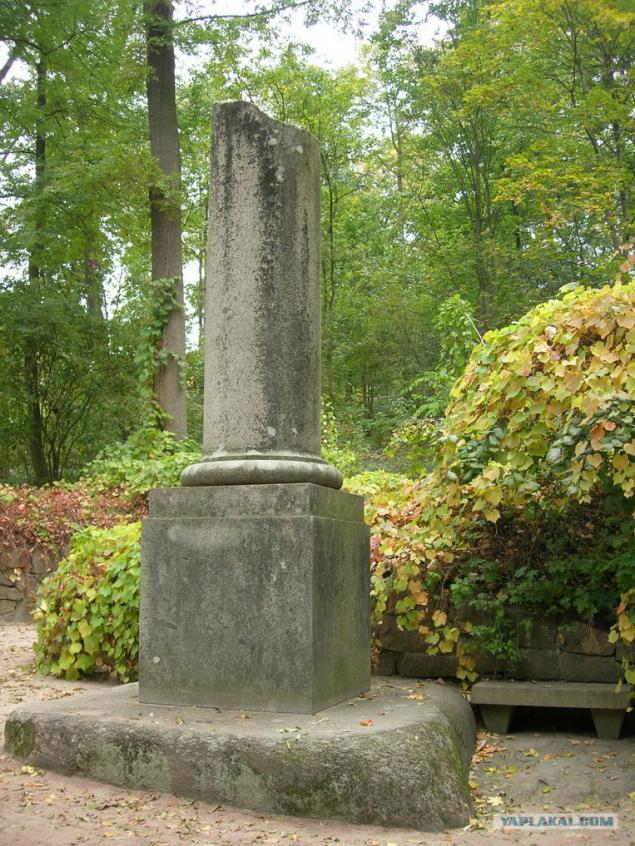
Source:
As planned by the creators of the park - "Sofiyivka" is a graphic illustration of the poems of Homer's "Iliad" and "Odyssey", each composition or architectural form contains certain ideas, it expresses the idea of myth and what that event. Here you can see the river Styx, Tarpeian Rock, numerous sculptures of ancient Greek heroes, writers, philosophers.
The main composition of the park runs along the bed of the Kamenka, which was built a number of separate pools and ponds: Upper - more than 8 hectares, Lower - about 1, 5 ha and other waterfalls (one of them 14 meters high), gateways, waterfalls, underground river Acheron.
The history of the park "Sofiyivka»
Sofievka was built the owner of the city of Uman Polish magnate Stanislav Potocki for his beloved wife, the beautiful Greek woman - Sofia.
The author of the topographical and architectural design, construction manager of the park was appointed a Polish military engineer Ludwig Metzel. Built his castle Potocki, but not for free - farmers were paid, it was dictated by the general chinshem, which was wound up Potocki.
Location for the park was very well chosen - a small river, oaks, ravines and piles of granite boulders, natural springs with crystal clear water ... From 1796 to 1802 digging ponds and trenches for underground rivers, constructed waterfalls, grottos were cut down, laid the alley. They were planted plants of both local and imported breeds from around the world. Garden decorated brought from Italy, marble statues of Greek gods and goddesses, philosophers and poets. Just a few years Uman builders and gardeners have created a miracle. The park was opened in May 1802, although the work had not yet been fully completed. Potocki presented the park on the day of Patron Saint Sophia and named in honor of her "Sofievka».
End Park on the original plan failed - Potocki died suddenly in 1805. After the death of Sophia Park was inherited by her son Alexander, however, for taking part in the Polish uprising of all the estates of Potocki, including Park were confiscated.
In the mid-19th century, the park was carried out restoration work, the construction of new facilities - such as the Rose Pavilion on the island of Anti-Circe, the pavilion of Flora Fountain and Snake.

The southern part of
1.home creative scientists of the National Academy of Sciences of Ukraine. This house has the original architecture, and on top of the building - an observation platform.

2. Park begins with the main entrance on the street Sadovaya. Behind him there is a central avenue. The main entrance of the Tower, erected in 1850-1852, respectively, survived to our time, along with an entrance gate. Fence from towers over one and a half centuries, has changed many times - from wood to clay-poster, a metal on granite columns.

3.Tsentralnaya alley.

4.Rechka Kamenka. It passes through the entire territory of the park.

5.Zhenevskoe lake.

6.Malaya Switzerland. Swamp cypress (planted in 1891).

7. Tayperskaya rock located to the right along the main avenue. It is a wooden gazebo light construction, which continues to rock. For the first time it established in 1839, and later, when the dilapidated - was removed, and only in 1950 was rebuilt again. The Rock is named the same as the western wall of the Capitoline fortress of Ancient Rome, which has been preserved to our time.

8. Near the Pavilion de Flore looks exquisite, thanks to its precise architectural forms, a tall column in the Doric style, bas-relief on the frieze, which depicts the leaves and bunches of grapes. Ornament executed in 1852 by academician of architecture drawings AI Shtakenshnejdera.

The central part of
9. In the framework of the composite decision of the central part of the park put scenes from the mythology of ancient Greece and Rome, and some places resemble the home of the Greek gods, heroes, writers and philosophers.
To the right of the pavilion of Flora is filled wedge of granite stone arch set the so-called Venetian bridge. The bridge is decorated with granite pylons, between which hang heavy forged chain. Slightly below the wooden bridge is the gateway to the passage of water into the channel of the river Kamenka.
In the middle of the Ionian Sea from the wide-open mouth of a snake writhing on the stone hits the water column - Fountain of Serpent.

10. Fountain Snake.

11.Ionicheskoe sea.

12.Venetsiansky bridge.

13.Granitnye Venetian bridge pylons.

14.Derevyanny gateway.

15. In the area on the top avenue - there is a statue of Hermes (the Romans - Mercury). This statue is located in the park since 1800, has repeatedly restored.

16.Verhnyaya alley.

17. At the end of the Lower alley located on a high granite pedestal, a two-meter statue of the ancient Greek poet playwright Euripides. It depicts a full-length with a scroll in his right hand and a bundle of manuscripts about the legs. Euripides is the only sculpture in the park, which is not rearranged to another place since its establishment in 1800. In 1996, all the original marble sculpture was moved to the museum, and in their place installed copies of plaster and Plexiglas.

18.Terrasa muses and Apollo grotto by the Assembly Square.

19.Apollon Belvedere.

20. On a square near the source of the podium in 1851 installed a statue of Venus bathing, which had previously stood in the grotto of Apollo. Now at this point is a copy in plexiglass, made in 1952. Below the statue from granite pedestal running spring water, which at any time of the year has the same temperature. Water fills the bronze half-shells, decorative depicting snakes, and poured it over the edge, flows down the granite underground channels in the Ionian Sea.

21. Through the Ionian Sea to the collecting area leads metal bridge with views of the Great Falls. Water comes here through the underground river Acheron from the Upper Pond. Built waterfall in the first period of the park.

22.Prohod a large waterfall.

23. The area is framed by wooden benches fees. It is situated on a peninsula oval. In the center is a swimming pool in the middle of which is placed a large granite vase. The pool swim ornamental fish. The water in the pool passes through the underground cast iron pipe from the Upper Pond and is kept at the same level, because the water level is displayed in the Ionian Sea through the padded underground granite canal. In summer, the vase is decorated with bright colors. Around the pool is a statue of Paris.

24. Statue of Paris.

25. The Valley of the Giants. To the left of the square is the grotto. A large granite boulder weighing more than 300 tons, hung without the support and rests only on three points. The reliability of this building checked by nature. In 1838, 1976, 1986, when there was a significant force Uman earthquake grotto remained intact. Grotto Grotto is called fear and doubt (early name - Grotto of Tantalus).

26. Above the grotto of Fear and doubt about Big Falls is a small pedestal. Once there was a statue of Cupid, made of white marble. From the original preserved only the wings of Cupid. In 1996, the photographs, she cast Kiev sculptor Ivan D. Didur from organic materials and is installed in its place. The statue depicts a boy who had scattered all his arrows, Teteven, which connects the ends of the bow, broken. In the background, Grand Falls.

27. Above Areas fees go up granite steps along the large granite boulders. To the left is West grotto (the grotto of Scylla). The grotto is made of pink granite, there are granite benches and a table.

28.Kamni symbolize the island of Ithaca.

29.On the same.

The eastern part of
30. Figure east of the statue is a bridge across the Amur River Kamenka track that leads to the Vale of Tempe. At this point, Ludwig Metzel tried to create a prototype of Greek Vale of Tempe. It grew 9 birches that allegorically displayed the nine sons Potocki. Two of them (Kostantin and Nicholas) had died at an early age, as Potocki's daughter Helena. As the memory of their early death in the valley of a granite obelisk, which is called "truncated column" (Column of Sorrow).

31. Near the creek flowing river Kamenka, divided into three separate small waterfall. They are called "Three Tears" and express their sorrow allegorical mother of three dead children.

32.Kolonna Sorrows.

Source:



